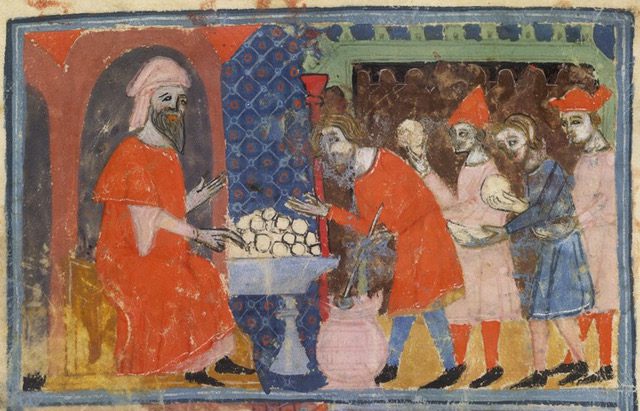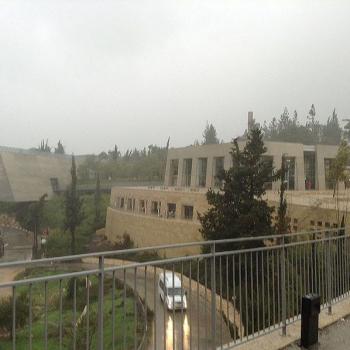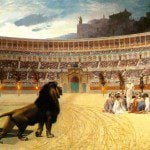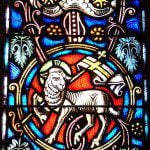
Wikimedia Commons public domain image
***
I came across a little piece online yesterday in which a rabbi declared that Christianized Passover meals or seders are anti-Semitic.
It got me to thinking, and I’m afraid that I’m going to disagree with him. Full disclosure: I myself have led perhaps half a dozen such Christianized seders, though probably not for at least five years or so. And I will say that — despite the eager accusations of a small handful of people who hate me — I genuinely don’t think that I harbor any actual anti-Semitism. Not even remotely. (For whatever little it’s worth, by the way, I’ll be accompanying a tour group to Israel later this month and again in October or thereabouts.) Although anti-Semitism (like racism) definitely exists and is definitely evil, accusations of anti-Semitism (like charges of racism) can be and, I think, often are tossed around far too casually, even illicitly weaponized — which, in my judgment, does nobody any good. (It can even do overall harm, rather like the traditional story of “The Boy Who Cried ‘Wolf!’.”)
Now, I’m acutely aware of the perils and likely offenses that can arise out of appropriating other people’s religious symbols. I’ve wondered, for example, how Buddhists feel about seeing stone images of the Buddha used as mere garden ornaments and fixtures in fountains. I dislike seeing celebrities who, putting it very mildly, show no apparent traces of Christian commitment wearing crosses around their necks as no more than fashion accessories. Years ago, I saw photos from a fashion show in which the little bit of cloth worn by one of the models was covered with quotations from the Qur’an; I wondered, of course, whether the dress designer in question suffered from a death wish, but I also objected to the act as profoundly, profoundly disrespectful.
However, my fundamental reason for disagreeing with the rabbi’s declaration comes down, precisely, to the question of whether the Passover seder is actually another people’s proprietary religious symbol.
First of all, though, in order to make my intent clear, permit me to draw an analogy from my own experience:
Years ago, without any intent to be offensive, a friend of mine in the United Kingdom passingly distinguished between my history (which, he said, was in the United States) and his own history as an Englishman. As the conversation proceeded, I didn’t respond to him on that subject. But I began to reflect about his distinction. My maternal roots are overwhelmingly from Yorkshire in the north of England, from Hampshire in the south, and, over the Scottish border, from Ayrshire. Most if not all of my maternal ancestors lived in the British Isles until at least 1700. In fact, a very important contingent of them didn’t arrive in North America until after 1850, following their conversion to the Church of Jesus Christ of Latter-day Saints.
Which means that, if British history prior to 1700 or even 1850 isn’t part of my family’s history, I have no family history on my maternal side before the eighteenth century. Which seems rather absurd. Were we created ex nihilo? Was my family really completely unaffected by feudalism, Magna Carta, the English Reformation, the, the Age of Exploration, the Glorious Revolution of 1688, and, even, the beginnings of the Industrial Revolution? Were my ancestors never onlookers at jousting tournaments or medieval mystery plays? Did they never see an English cathedral or sing traditional English carols and folk songs?
My contention is simply this: Up to the point that my ancestors left the British Isles, British history and culture are as much a part of my personal family history, in a very real sense, they are as much a part of my personal family history as they are of the family histories of English men and women living today in Kent, the Lake District, London, or the Isle of Wight. And, in an even stronger sense, as they are of the family histories of similarly-descended men and women living today in Canada, Australia, and New Zealand, and even in South Africa, Zimbabwe, and Kenya. Chaucer and Shakespeare and Milton and even Jane Austen are part of my heritage, too. They’re not foreign to me.
Now back to the question of Passover seders:
I’ll pass over the question, controversial in some circles, of the historicity of the events recorded in Exodus. For purposes of this discussion, I’ll simply assume them to be true.
Some believing Jews would no doubt argue for the identity of their current faith, as it exists today, with that of their lawgiver, Moses. They believe that the teachings of the rabbis are part of the oral tradition, passed down over many centuries. And it’s perfectly fine for them to do so. Most outside historians, though, whether believers or not, accept the idea that Judaism as it exists today, while its roots are plainly and undeniably in the Torah, has evolved since then. The pre-exilic religion of the First Temple and the post-exilic religion of the Second Temple, somewhat different from each other and substantially different from the religious practices and teachings of the patriarchs and wandering tribes, were unavoidably transformed by the complete destruction of the Temple of Jerusalem in AD 70. In the wake of that catastrophe, the Pharisees of the New Testament — the Sadducees having essentially disappeared after the razing of the temple, from which derived their status and authority — gradually became the rabbis who created not only the Mishnah and the Talmuds but rabbinic Judaism as we know it today.
In other words, rabbinic Judaism is plainly a legitimate descendant of the religion of Moses and the Children of Israel, but it is, arguably, not exactly identical with it.
The same, though, can be argued for Christianity. The Jesus movement coalesced around a Jew, whose original twelve apostles were also Jews. Its most famous first century missionary was a man who was originally named Saul of Tarsus, who once described himself as having been “circumcised the eighth day, of the stock of Israel, of the tribe of Benjamin, an Hebrew of the Hebrews; as touching the law, a Pharisee” (Philippians 3:5), and who did much of his proselytizing not only near synagogues but in them.
Moses is an important prophetic figure in Christian thinking, just as he is in Jewish thinking. The Hebrew Bible is a part of the Christian Bible. The Tanakh, as it is often called, is the Christian “Old Testament.”
In other words — just as Spanish, Portuguese, French, Italian, Romanian, and Romansch are all, more or less equally, descendants of (and therefore legitimate heirs to) Latin — Christianity, along with rabbinic Judaism, is plainly a legitimate descendant of the religion of Moses and the Children of Israel, although it is, arguably, not exactly the same thing.
The celebration of the Eucharist in Catholic worship services plainly derives from the Last Supper as depicted in the New Testament gospels. So does Lutheran celebration of the Eucharist. The Lutheran Church broke off from the Catholic Church during the German Reformation and substantially revised the order of worship in its Sunday services, but it would be inflammatory and unjust to pronounce Lutheran celebrations of the Eucharist intrinsically anti-Catholic. And, although the Eucharist in mainstream Christianity — the “sacrament [of the Lord’s supper]” in the Restored Church — plainly has the Last Supper as its model, which, the synoptic gospels strongly suggest to have been a Passover meal, it would be wrong and incendiary to brand its Christian commemorations as anti-Semitic.
Jews and Christians disagree — are free and welcome to disagree — about whose descent is most faithful to the original, but they cannot deny their common paternity. Thus, I would contend, “Christianized” Passover services are neither somehow illegitimate nor in any way intrinsically anti-Semitic. They are simply an effort to appropriate early symbols from a common tradition for specifically Christian use and edification. And here I will add that, as a believing Christian, I regard them as potentially excellent teaching tools, not only with regard to the Hebrew biblical story of the deliverance of Israel from Egyptian bondage and the institution of the ancient Passover, but with regard to the atoning story of Jesus. As a Christian heir to the story of Moses in the Hebrew Bible, I believe him to be our Deliverer from bondage and death, and the fulfillment, on a far grander scale, of the liberating hopes embodied in the story of Exodus.
In saying this, I don’t mean to give offense. We owe charity and respect to all of those around us whose beliefs may differ from ours, and we owe a special debt of kindness and deference to our Jewish neighbors in particular, who have suffered so brutally and so long at the hands of our supposed fellow “Christians.” But, while we are obliged to be sensitive and respectful, we are not obliged to surrender our own beliefs, nor to pretend that the Old Testament isn’t a part of our own canon of scripture. As Saul of Tarsus says at Ephesians 4:15, we are to “speak the truth in love.”












